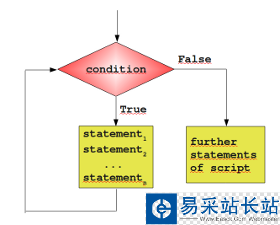本章节将为大家介绍Python循环语句的使用。
Python中的循环语句有 for 和 while。
Python循环语句的控制结构图如下所示:

while 循环
Python中while语句的一般形式:
while 判断条件:
语句
同样需要注意冒号和缩进。另外,在Python中没有do..while循环。
以下实例使用了 while 来计算 1 到 100 的总和:
#!/usr/bin/env python3 n = 100 sum = 0counter = 1while counter <= n: sum = sum + counter counter += 1 print("1 到 %d 之和为: %d" % (n,sum))执行结果如下:
1 到 100 之和为: 5050
无限循环
我们可以通过设置条件表达式永远不为 false 来实现无限循环,实例如下:
#!/usr/bin/python3 var = 1while var == 1 : # 表达式永远为 true num = int(input("输入一个数字 :")) print ("你输入的数字是: ", num) print ("Good bye!")执行以上脚本,输出结果如下:
输入一个数字 :5
你输入的数字是: 5
输入一个数字 :
你可以使用 CTRL+C 来退出当前的无限循环。
无限循环在服务器上客户端的实时请求非常有用。
while 循环使用 else 语句
在 while … else 在条件语句为 false 时执行 else 的语句块:
#!/usr/bin/python3 count = 0while count < 5: print (count, " 小于 5") count = count + 1else: print (count, " 大于或等于 5")
执行以上脚本,输出结果如下:
0 小于 5
1 小于 5
2 小于 5
3 小于 5
4 小于 5
5 大于或等于 5
简单语句组
类似if语句的语法,如果你的while循环体中只有一条语句,你可以将该语句与while写在同一行中, 如下所示:
#!/usr/bin/python flag = 1 while (flag): print ('欢迎访问武林站长站!') print ("Good bye!")注意:以上的无限循环你可以使用 CTRL+C 来中断循环。
执行以上脚本,输出结果如下:
for 语句
Python for循环可以遍历任何序列的项目,如一个列表或者一个字符串。
for循环的一般格式如下:
for <variable> in <sequence>: <statements>else: <statements>
Python loop循环实例:
实例
>>>languages = ["C", "C++", "Perl", "Python"] >>> for x in languages:... print (x)... CC++PerlPython>>>
以下 for 实例中使用了 break 语句,break 语句用于跳出当前循环体:
实例
#!/usr/bin/python3 sites = ["Baidu", "Google","jb51","Taobao"]for site in sites: if site == "jb51": print("武林站长站!") break print("循环数据 " + site)else: print("没有循环数据!")print("完成循环!")
新闻热点
疑难解答